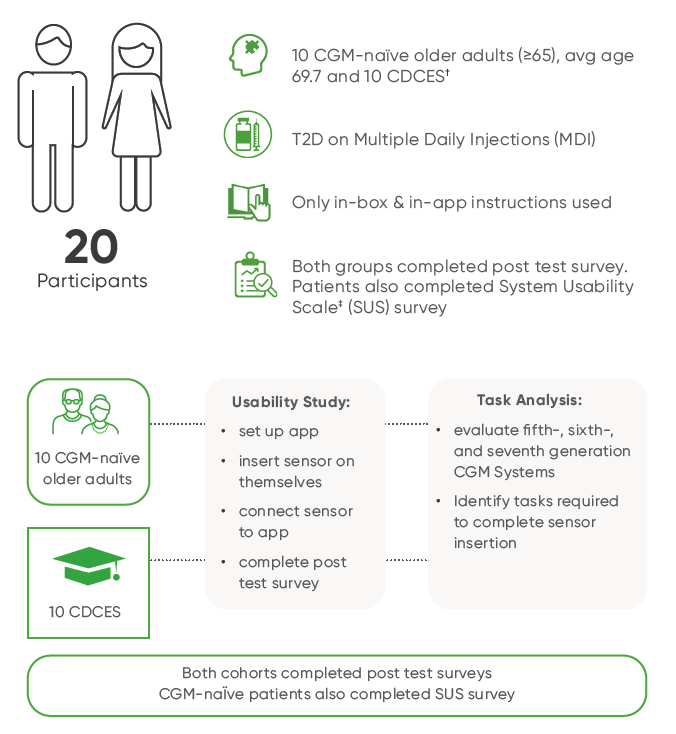Dexcom G7 CGM Ease of Use Study
Disclaimer: © The authors. All rights reserved. This is a privileged document currently under peer-review/community review. Authors have provided JMIR Publications with an exclusive license to publish this preprint on it's website for review purposes only. While the final peer-reviewed paper may be licensed under a CC BY license on publication, at this stage authors and publisher expressively prohibit redistribution of this draft paper other than for review purposes.
Usability and Teachability of Continuous Glucose Monitoring (CGM) Devices in Older Adults and Diabetes Educators: a Task Analysis and Ease of Use Survey
Simon Psavko, Noam Katz, Tina Mirchi, Courtney R Green.* Submitted to: JMIR Human Factors on: August 19, 2022 (currently under peer/community review).
Background
It is important for diabetes technology to be easy to use. Ease of use can increase adoption of CGM, particularly in older adults. Recent studies have demonstrated improved glycemic outcomes with the use of CGM in older adults.1-2
Objective
The purpose of this study was to evaluate the ease of use of Dexcom G7 CGM in older adults (≥65) and diabetes educators.
Study Outcomes Measured
- To assess if older adults found G7 easy to setup;
- To assess if CDCESs found G7 easier to train on than other CGM systems they worked with.
Participant Eligibility & Study Design

Results
All CGM-naïve, older adult participants and CDCES participants successfully completed G7 app setup and sensor insertion. Time on task was recorded from the start of app setup through onboarding completion (including sensor insertion). Sensor insertion time was also recorded, with insertion time ranging from 58 seconds to three minutes (average = 1.95 minutes).3

KEY TAKEAWAYS
- First ease of use study of Dexcom G7 RT-CGM.
- G7 sensor was easier to insert and set up and had fewer potential unrecoverable use errors compared to previous generations of the device.4
- Ease of use can improve utilization of CGM in older adults. Increased use of CGM in this population can lead to improved glycemic outcomes.5-6
*The author(s) declared the following potential conflicts of interest with respect to the research, authorship, and/or publication of this article: The authors are employees and stockholders of Dexcom, Inc.
† Certified Diabetes Care and Education Specialist
‡ Brooke J. SUS: A quick and dirty usability scale. Usability Eval Ind. 1995 Nov 30;189.
1. Pratley RE, Kanapka LG, Rickels MR, Ahmann A, Aleppo G, Beck R, et al. Effect of continuous glucose monitoring on hypoglycemia in older adults with type 1 diabetes: A randomized clinical trial. JAMA. 2020 Jun 16;323(23):2397-406. PMID: 32543682. doi: 10.1001/jama.2020.6928.
2. Miller KM, Kanapka LG, Rickels MR, Ahmann AJ, Aleppo G, Ang L, et al. Benefit of Continuous Glucose Monitoring in Reducing Hypoglycemia Is Sustained Through 12 Months of Use Among Older Adults with Type 1 Diabetes. Diabetes Technol Ther. 2022 Jun;24(6):424-34. PMID: 35294272. doi: 10.1089/dia.2021.0503.
3. Psavko S, Katz N, Mirchi T, Green CR. Usability and teachability of continuous glucose monitoring devices in older adults and diabetes educators: a task analysis and ease of use survey. JMIR Hum Factors. 2022 Nov 8. doi: 10.2196/42057.
4. Welsh JB, Psavko S, Zhang X, Gao P, Balo AK. Comparisons of Fifth-, Sixth-, and Seventh- Generation Continuous Glucose Monitoring Systems. J Diabetes Sci Technol. 2022 Jun 13:19322968221099879. PMID: 35695305. doi: 10.1177/19322968221099879.
5. Pratley RE, Kanapka LG, Rickels MR, Ahmann A, Aleppo G, Beck R, et al. Effect of continuous glucose monitoring on hypoglycemia in older adults with type 1 diabetes: A randomized clinical trial. JAMA. 2020 Jun 16;323(23):2397-406. PMID: 32543682. doi: 10.1001/jama.2020.6928.
6. Miller KM, Kanapka LG, Rickels MR, Ahmann AJ, Aleppo G, Ang L, et al. Benefit of Continuous Glucose Monitoring in Reducing Hypoglycemia Is Sustained Through 12 Months of Use Among Older Adults with Type 1 Diabetes. Diabetes Technol Ther. 2022 Jun;24(6):424-34. PMID: 35294272. doi: 10.1089/dia.2021.0503.